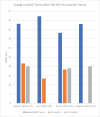High Intensity Focused Ultrasound - Longitudinal Data on Efficacy and Safety
- PMID: 40351562
- PMCID: PMC12063574
- DOI: 10.5334/tohm.987
High Intensity Focused Ultrasound - Longitudinal Data on Efficacy and Safety
Abstract
Background: High intensity focused ultrasound (HiFU) is a relatively new incisionless intervention used for treatment of essential tremor and Parkinson's disease tremor. Understanding the indications, benefits, risks and limitations of HiFU, as well as how it compares to deep brain stimulation (DBS), is important in guiding appropriate recommendations for prospective patients.
Methods: Current literature on efficacy and safety of HiFU in essential tremor and Parkinson's disease was reviewed. We additionally reviewed data on the patients who presented to our center for HiFU consultation, including outcomes of patients with low skull density ratios, and distances traveled for the procedure.
Results/discussion: HiFU is an effective and generally well-tolerated treatment for tremor. Adverse events, especially gait instability, are typically temporary but should be discussed with patients. The risk of tremor recurrence in certain patients with Parkinson's disease is also of note. Identifying appropriate candidates for either intervention remains crucial and involves considering each patient's circumstances and preferences, potential adverse effects, and practical aspects like access to follow-up and expectations. Data on bilateral HiFU lesioning, use of HiFU in patients with low skull density ratios, and emerging targets like the pallidothalamic tract are discussed as well.
Keywords: Essential Tremor; Focused Ultrasound; HiFU; High Intensity; Parkinson’s Disease.
Copyright: © 2025 The Author(s).
Conflict of interest statement
The authors have no competing interests to declare.
Figures













References
-
- Chang WS, Jung HH, Zadicario E, Rachmilevitch I, Tlusty T, Vitek S, Chang JW. Factors associated with successful magnetic resonance-guided focused ultrasound treatment: efficiency of acoustic energy delivery through the skull. J Neurosurg. 2016. Feb;124(2):411–6. DOI: 10.3171/2015.3.JNS142592 - DOI - PubMed
-
- Boutet A, Gwun D, Gramer R, Ranjan M, Elias GJB, Tilden D, Huang Y, Li SX, Davidson B, Lu H, Tyrrell P, Jones RM, Fasano A, Hynynen K, Kucharczyk W, Schwartz ML, Lozano AM. The relevance of skull density ratio in selecting candidates for transcranial MR-guided focused ultrasound. J Neurosurg. 2019. May 3;132(6):1785–1791. DOI: 10.3171/2019.2.JNS182571 - DOI - PubMed
-
- Vetkas A, Boutet A, Sarica C, Germann J, Gwun D, Yamamoto K, Jung HH, Alkhotani A, Samuel N, Lang S, Conner CR, Elias GJB, Cheyuo C, Chow C, Santyr B, Iorio-Morin C, Yang AZ, Candeias da Silva C, Fasano A, Kalia SK, Lozano AM. Successful magnetic resonance-guided focused ultrasound treatment of tremor in patients with a skull density ratio of 0.4 or less. J Neurosurg. 2023. Sep 1;140(3):639–647. DOI: 10.3171/2023.6.JNS23171 - DOI - PubMed
-
- Elias WJ, Lipsman N, Ondo WG, Ghanouni P, Kim YG, Lee W, Schwartz M, Hynynen K, Lozano AM, Shah BB, Huss D, Dallapiazza RF, Gwinn R, Witt J, Ro S, Eisenberg HM, Fishman PS, Gandhi D, Halpern CH, Chuang R, Butts Pauly K, Tierney TS, Hayes MT, Cosgrove GR, Yamaguchi T, Abe K, Taira T, Chang JW. A Randomized Trial of Focused Ultrasound Thalamotomy for Essential Tremor. N Engl J Med. 2016. Aug 25;375(8):730–9. DOI: 10.1056/NEJMoa1600159 - DOI - PubMed
Publication types
MeSH terms
LinkOut - more resources
Full Text Sources
Medical

